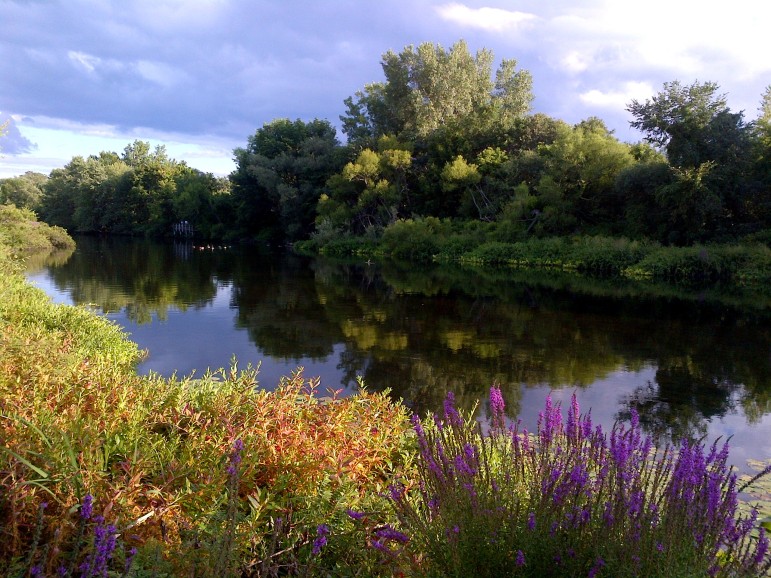
Chuck Dickinson The Charles River in Watertown.
This article is part of a series on local history provided by the Historical Society of Watertown. It was written by Paul Brennan, former President and former Vice President of the Historical Society. It was published in our October 1998 newsletter, “The Town Crier.”
THE CHARLES RIVER, LONG AGO
The Native American name for the Charles River was Quineboquin. That name described the river’s flow and means “circular” in the native language of the Algonquin Tribe which occupied the area for more than 6,000 years.
The native Americans used the river to sustain their lives in hunting and fishing and for recreation and travel. Although the seal of Watertown shows an Englishman trading a biscuit for a bass with a native, there is no real evidence to support that there was an occupying tribe on the northern side of the river when the English first came to settle here. There has been an abundance of prehistoric artifacts uncovered within the boundaries of Watertown but they suggest the land’s use was for either resting places for the dead or migratory hunting periods. The artifacts include stone tools, arrowheads, and several cremation pits.
The native population did manage a weir on the river near the falls to catch a bounty of fish during spawning seasons. This was the only altering effect that the native population had on the river.
There have been arguments given that the Charles River was occupied by Norse settlers 600 years before the English. A lengthy and detailed opinion was written by Eben Norton Horsford, a member of the Historical Society of Watertown, in 1889, expounding on this theory. It was called The Discovery of the Ancient City of Norumbega. Horsford paid for a tower to be erected to celebrate his theory, which still stands today. To date, no solid evidence has withstood the test of scrutiny.
In 1614, Captain John Smith traveled up the Quineboquin and, thinking this was the great river leading to the continent’s interior, named it for the King of England, Charles I.
In 1630, Sir Richard Saltonstall and about 12 families under his guidance, sailed four miles up the Charles River and placed their settlement on what is now a landing near the Mount Auburn Hospital.
The name Watertown was used by the Court of the Massachusetts Bay Company when giving the town its charter but was probably conceived by the group of families because of their search for a well watered area. There were many tributary inlets along the Charles River within Watertown’s original boundaries, all of which are now covered or diverted. The majority of the early families were interested in farming and their interest in the river was for fishing. Fish was also an early tool used for fertilizing crops.
The need to process their harvests followed very soon and then again impacted the river for use of its power to create a grist mill. They soon were able to cross its banks by erecting a small foot bridge.
By the fourth year of the English settlement, the river was used by the new occupants for all of the same reasons the native population had used it for: hunting, fishing, recreation and travel. But the new settlers had one very great addition: the harnessing of its power to expand their industries.
It’s Quinobequin, folks.
Thank you for having published a bit of the history of the Charles River.
While it may have exceeded desired space, the article would have been a bit more comprehensive if it had included the original English name for the river. Cited in various sources and in an engraved story on the bridge which I photograph but have yet to find, the native name of the river, Quineboqui, was renamed “Massachusetts River” by Captain Smith. Upon presenting King Charles I maps and place names of the region Smith suggested that the King rename anything to his liking.
Perhaps if photographs of historical plaques or engravings are to be published, the history engraved in the bridge could included.
Tom Stevens, former resident of Watertown, now residing in North Carolina which also was named for King Charles I.
Back in the 1950s, we were taught that the best translation of “Quinobequin” (regardless of how you might transliterate the sound of the term in original language) was “river that turns on itself.” That seems a good interpretation of a name/phrase that includes the idea of circularity and travel.